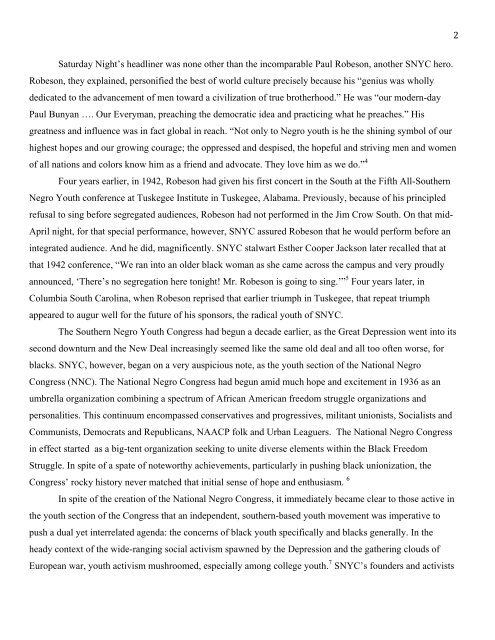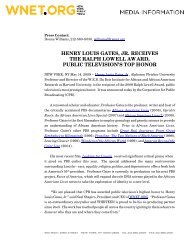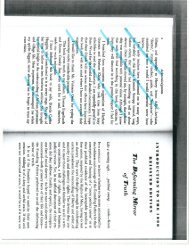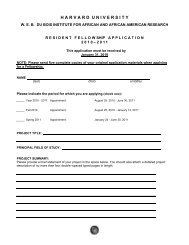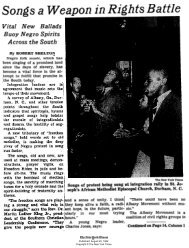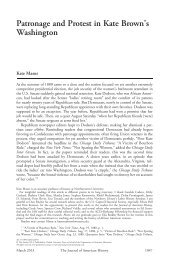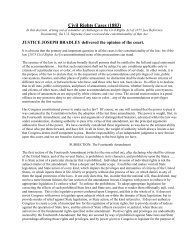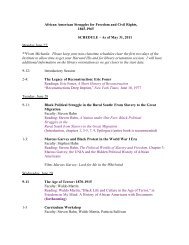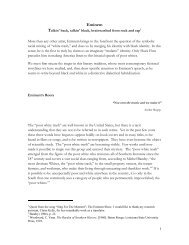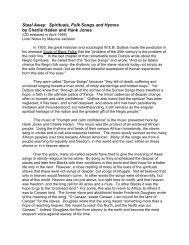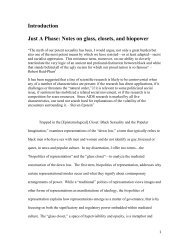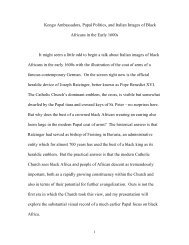SNYC, SNCC, Black Student Activism and the Making of the ...
SNYC, SNCC, Black Student Activism and the Making of the ...
SNYC, SNCC, Black Student Activism and the Making of the ...
Create successful ePaper yourself
Turn your PDF publications into a flip-book with our unique Google optimized e-Paper software.
2<br />
Saturday Night’s headliner was none o<strong>the</strong>r than <strong>the</strong> incomparable Paul Robeson, ano<strong>the</strong>r <strong>SNYC</strong> hero.<br />
Robeson, <strong>the</strong>y explained, personified <strong>the</strong> best <strong>of</strong> world culture precisely because his “genius was wholly<br />
dedicated to <strong>the</strong> advancement <strong>of</strong> men toward a civilization <strong>of</strong> true bro<strong>the</strong>rhood.” He was “our modern-day<br />
Paul Bunyan …. Our Everyman, preaching <strong>the</strong> democratic idea <strong>and</strong> practicing what he preaches.” His<br />
greatness <strong>and</strong> influence was in fact global in reach. “Not only to Negro youth is he <strong>the</strong> shining symbol <strong>of</strong> our<br />
highest hopes <strong>and</strong> our growing courage; <strong>the</strong> oppressed <strong>and</strong> despised, <strong>the</strong> hopeful <strong>and</strong> striving men <strong>and</strong> women<br />
<strong>of</strong> all nations <strong>and</strong> colors know him as a friend <strong>and</strong> advocate. They love him as we do.” 4<br />
Four years earlier, in 1942, Robeson had given his first concert in <strong>the</strong> South at <strong>the</strong> Fifth All-Sou<strong>the</strong>rn<br />
Negro Youth conference at Tuskegee Institute in Tuskegee, Alabama. Previously, because <strong>of</strong> his principled<br />
refusal to sing before segregated audiences, Robeson had not performed in <strong>the</strong> Jim Crow South. On that mid-<br />
April night, for that special performance, however, <strong>SNYC</strong> assured Robeson that he would perform before an<br />
integrated audience. And he did, magnificently. <strong>SNYC</strong> stalwart Es<strong>the</strong>r Cooper Jackson later recalled that at<br />
that 1942 conference, “We ran into an older black woman as she came across <strong>the</strong> campus <strong>and</strong> very proudly<br />
announced, ‘There’s no segregation here tonight! Mr. Robeson is going to sing.’” 5 Four years later, in<br />
Columbia South Carolina, when Robeson reprised that earlier triumph in Tuskegee, that repeat triumph<br />
appeared to augur well for <strong>the</strong> future <strong>of</strong> his sponsors, <strong>the</strong> radical youth <strong>of</strong> <strong>SNYC</strong>.<br />
The Sou<strong>the</strong>rn Negro Youth Congress had begun a decade earlier, as <strong>the</strong> Great Depression went into its<br />
second downturn <strong>and</strong> <strong>the</strong> New Deal increasingly seemed like <strong>the</strong> same old deal <strong>and</strong> all too <strong>of</strong>ten worse, for<br />
blacks. <strong>SNYC</strong>, however, began on a very auspicious note, as <strong>the</strong> youth section <strong>of</strong> <strong>the</strong> National Negro<br />
Congress (NNC). The National Negro Congress had begun amid much hope <strong>and</strong> excitement in 1936 as an<br />
umbrella organization combining a spectrum <strong>of</strong> African American freedom struggle organizations <strong>and</strong><br />
personalities. This continuum encompassed conservatives <strong>and</strong> progressives, militant unionists, Socialists <strong>and</strong><br />
Communists, Democrats <strong>and</strong> Republicans, NAACP folk <strong>and</strong> Urban Leaguers. The National Negro Congress<br />
in effect started as a big-tent organization seeking to unite diverse elements within <strong>the</strong> <strong>Black</strong> Freedom<br />
Struggle. In spite <strong>of</strong> a spate <strong>of</strong> noteworthy achievements, particularly in pushing black unionization, <strong>the</strong><br />
Congress’ rocky history never matched that initial sense <strong>of</strong> hope <strong>and</strong> enthusiasm. 6<br />
In spite <strong>of</strong> <strong>the</strong> creation <strong>of</strong> <strong>the</strong> National Negro Congress, it immediately became clear to those active in<br />
<strong>the</strong> youth section <strong>of</strong> <strong>the</strong> Congress that an independent, sou<strong>the</strong>rn-based youth movement was imperative to<br />
push a dual yet interrelated agenda: <strong>the</strong> concerns <strong>of</strong> black youth specifically <strong>and</strong> blacks generally. In <strong>the</strong><br />
heady context <strong>of</strong> <strong>the</strong> wide-ranging social activism spawned by <strong>the</strong> Depression <strong>and</strong> <strong>the</strong> ga<strong>the</strong>ring clouds <strong>of</strong><br />
European war, youth activism mushroomed, especially among college youth. 7 <strong>SNYC</strong>’s founders <strong>and</strong> activists


